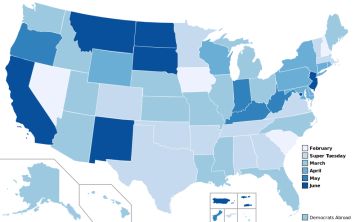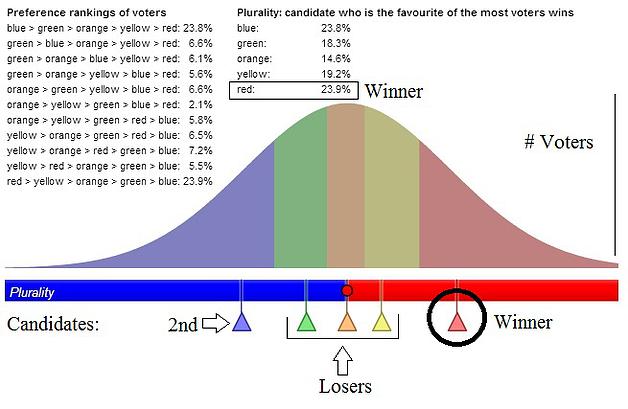One Thing Is Certain: America Clearly Fails at Presidential Elections

Let’s be clear on something. The way we do primaries is bad. There’s the saying that imitation is the best form of flattery. No one is imitating us. No flattery going on. We’re just doing a bad job.
Let’s start with how long our marathon primaries go on. Iowa, the compulsive early starter, began the primary/caucus season this year on February 1. That’s nine months before the general election. That means American voters hear about candidates over a year before the election takes place. Consequently, we limit the pool of candidates to those who can afford to campaign for an entire year.
Another peculiarity is that these primaries take place not just early, but they’re scattered throughout the whole year. And because voters in primaries can choose only one candidate, if that candidate later drops out, then all those votes were for nothing.
This insistence on choosing a single candidate — called plurality voting — has a particular effect in primaries. Primaries tend to have a number of similar candidates. And when you can only vote for one person in a slate of similar candidates, then you get a division of votes around the middle.
This division within the middle benefits more partisan candidates. This partisan outcome is exaggerated because it’s already taking place in an election with partisan voters in partisan parties. This is called a “center squeeze” effect.
Can you think of any partisan candidates who’ve benefited from this in this election cycle?
This vote-for-one restriction in primaries extends itself to polling. And it’s these polls that are used to determine who gets into debates. Unfortunately, this means that because of vote splitting some candidates get artificially low support.
For example, few voters even realized that Lawrence Lessig was running in the Democratic race, even though his campaign raised over a million dollars. That’s because no one wants to waste their only vote on a candidate with questionable winning chances.
Unfortunately for Lessig, our choose-one voting method gave him artificially low support and cost him a seat in the debates. (The Democrats also chose not to go for the more inclusive debate model used by the Republican Party.)
Yet another peculiarity within primaries are superdelegates. Votes from superdelegates carry much more weight than a vote from someone like you or me.
One might look at this and think superdelegates violate the one person, one vote principle. They do. Clearly. But that’s when we have to remind ourselves that these are primaries put together by political parties. And these political parties are private organizations, independent of government despite where they occupy their time.
In a peculiar public-private hybrid, primaries grant party insiders the ability to create internal rules awarding themselves lopsided power. In addition to this benefit of control, they also pass the cost of their elections off to the public. In other countries, primaries are the parties’ responsibility, and those parties alone bear the cost.
You may also be curious why political parties have things like superdelegates. In practice, they’ve tended to follow the popular vote, but they don’t have to. Democratic Party Chair Wasserman Schultz can explain: “Unpledged delegates exist really to make sure that party leaders and elected officials don’t have to be in a position where they are running against grassroots activists.”
That doesn’t exactly sound like the voters are in control.
So what are some solutions here?
One approach is to try to control the parties despite the fact that they’re private organizations. This is an uphill battle. Congress has the ability to control when and how U.S. House and Senate elections take place. And they have used this power before.
Article I Section 4 of the Constitution granting this right to control federal elections doesn’t mention presidential candidates. But passing such a law would make it impractical for states to hold primaries for different positions on different dates. The question would be whether you could force a time window on these private parties.
We can attempt this same strategy of federal legislation to uniformly allow voters to choose as many candidates as they want instead of just one — called approval voting. Approval voting would solve candidates not being able to choose their honest favorites — the obstacle Lessig ran into. And if some candidates dropped out, voters who chose other candidates would still have a meaningful ballot as the election went on.
As far as superdelegates, again because parties are private organizations, we face the same challenges. And even if Congress could act to get rid of superdelegates, why would they want to given that members of Congress belong to these very parties?
The other solution is to simply embrace the fact that political parties are private organizations. That means leaving them to their own devices on how they choose the candidate. But it also means making them pay for their own primary elections. There’s no reason why private political parties should be able to have their cake and eat it too.
But if we’re to leave the parties alone to choosing their nominees, then we must do something about how we elect people in the general election. One tool we can use is the ballot initiative process. We can do this since we’re no longer talking about private parties. This would also sidestep the obvious conflict of interest that incumbents face when choosing their own election laws.
And the reform itself? Quite simply, we must run general elections so that voters can choose as many candidates as they want. That is, we must use approval voting.
Using approval voting in the general elections mitigates the power of parties. By removing the fear of wasting your vote, approval voting lowers the barrier to entry, which encourages competition.
Plus, no one gets accused of being a spoiler, which means major parties may be less motivated to create ballot access barriers for independents and third parties. And with candidates getting a more accurate measure of support, popular independents and third parties could even make it to the debate stage. They wouldn’t even have to be billionaires.
So you want better elections? Jump past the primaries where reform is more futile, and instead think about the general election. Then use approval voting. Until we get a real reform that gives voters real power, our democracy will continue to be very weak. Token involvement through an inexpressive choose-one voting method doesn’t give us the power we need.
Editor's note: This article originally published on the Center for Election Science's blog on February 29, 2016, and has been modified slightly for publication.








